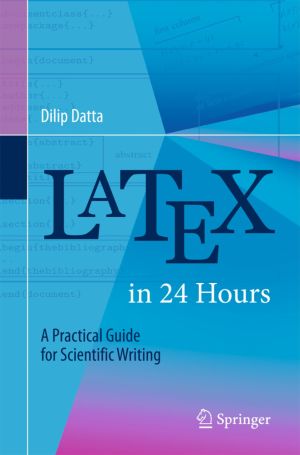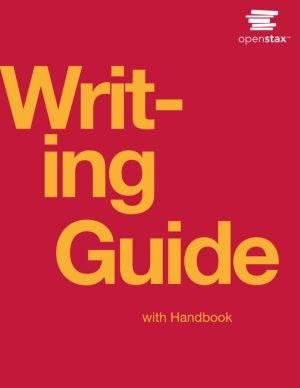Writing Guide with Handbook
by Michelle Bachelor Robinson, Maria Jerskey, Toby Fulwiler
DescriptionTable of ContentsDetailsHashtagsReport an issue
Writing Guide with Handbook breaks down barriers in the field of composition by offering an inviting and inclusive approach to students of all intersectional identities. To meet this goal, the text creates a reciprocal relationship between everyday rhetoric and the evolving world of academia. Writing Guide with Handbook builds on students' life experiences and their participation in rhetorical communities within the familiar contexts of personal interaction and social media. The text seeks to extend these existing skills by showing students how to construct a variety of compelling compositions in a variety of formats, situations, and contexts.
The authors conceived and developed Writing Guide with Handbook in 2020; its content and learning experiences reflect the instructional, societal, and individual challenges students have faced. The authors invite students and instructors to practice invitational discussions even as they engage in verbal and written argument. Instructors will be empowered to emphasize meaning and voice and to teach empathy as a rhetorical strategy. Students will be empowered to negotiate their identities and their cultures through language as they join us in writing, discovering, learning, and creating. 






Book Description
Writing Guide with Handbook aligns to the goals, topics, and objectives of many first-year writing and composition courses. It is organized according to relevant genres, and focuses on the writing process, effective writing practices or strategies - including graphic organizers, writing frames, and word banks to support visual learning - and conventions of usage and style. The text includes an editing and documentation handbook, which provides information on grammar and mechanics, common usage errors, and citation styles.Writing Guide with Handbook breaks down barriers in the field of composition by offering an inviting and inclusive approach to students of all intersectional identities. To meet this goal, the text creates a reciprocal relationship between everyday rhetoric and the evolving world of academia. Writing Guide with Handbook builds on students' life experiences and their participation in rhetorical communities within the familiar contexts of personal interaction and social media. The text seeks to extend these existing skills by showing students how to construct a variety of compelling compositions in a variety of formats, situations, and contexts.
The authors conceived and developed Writing Guide with Handbook in 2020; its content and learning experiences reflect the instructional, societal, and individual challenges students have faced. The authors invite students and instructors to practice invitational discussions even as they engage in verbal and written argument. Instructors will be empowered to emphasize meaning and voice and to teach empathy as a rhetorical strategy. Students will be empowered to negotiate their identities and their cultures through language as they join us in writing, discovering, learning, and creating.
This open book is licensed under a Creative Commons License (CC BY). You can download Writing Guide with Handbook ebook for free in PDF format (63.3 MB).
Table of Contents
Unit 1
The Things We Carry: Experience, Culture, and Language
Chapter 1
The Digital World: Building on What You Already Know to Respond Critically
Chapter 2
Language, Identity, and Culture: Exploring, Employing, Embracing
Chapter 3
Literacy Narrative: Building Bridges, Bridging Gaps
Unit 2
Bridging the Divide Between Personal Identity and Academia
Chapter 4
Memoir or Personal Narrative: Learning Lessons from the Personal
Chapter 5
Profile: Telling a Rich and Compelling Story
Chapter 6
Proposal: Writing About Problems and Solutions
Chapter 7
Evaluation or Review: Would You Recommend It?
Chapter 8
Analytical Report: Writing from Facts
Chapter 9
Rhetorical Analysis: Interpreting the Art of Rhetoric
Chapter 10
Position Argument: Practicing the Art of Rhetoric
Chapter 11
Reasoning Strategies: Improving Critical Thinking
Chapter 12
Argumentative Research: Enhancing the Art of Rhetoric with Evidence
Chapter 13
Research Process: Accessing and Recording Information
Chapter 14
Annotated Bibliography: Gathering, Evaluating, and Documenting Sources
Chapter 15
Case Study Profile: What One Person Says About All
Unit 3
Navigating Rhetoric in Real Life
Chapter 16
Print or Textual Analysis: What You Read
Chapter 17
Image Analysis: What You See
Chapter 18
Multimodal and Online Writing: Creative Interaction between Text and Image
Chapter 19
Scripting for the Public Forum: Writing to Speak
Chapter 20
Portfolio Reflection: Your Growth as a Writer
Book Details
Title
Writing Guide with Handbook
Subject
Education and Teaching
Publisher
OpenStax
Published
2021
Pages
756
Edition
1
Language
English
ISBN13
9781711494869
ISBN10
1711494860
ISBN13 Digital
9781951693473
ISBN10 Digital
1951693477
PDF Size
63.3 MB
License

Related Books

This biography examines the long life of the traveller and author Stephen Graham. Graham walked across large parts of the Tsarist Empire in the years before 1917, describing his adventures in a series of books and articles that helped to shape attitudes towards Russia in Britain and the United States. In later years he travelled widely across Europ...

This book is designed to introduce you to writing programs with the Go programming language. You'll learn how to write useful tools and applications that can run on remote servers, or local Windows, macOS, and Linux systems for development.
The topics that it covers include how to:
- Install and set up a local Go development environment on...

Cosmos DB is a NoSQL database service included in Azure that is continuously adding new features and has quickly become one of the most innovative services found in Azure, targeting mission-critical applications at a global scale. This book starts off by showing you the main features of Cosmos DB, their supported NoSQL data models and the foundatio...

For many researchers, Python is a first-class tool mainly because of its libraries for storing, manipulating, and gaining insight from data. Several resources exist for individual pieces of this data science stack, but only with the Python Data Science Handbook do you get them all - IPython, NumPy, Pandas, Matplotlib, Scikit-Learn, and other relate...

This book presents direct and concise explanations and examples to many LaTeX syntax and structures, allowing students and researchers to quickly understand the basics that are required for writing and preparing book manuscripts, journal articles, reports, presentation slides and academic theses and dissertations for publication.
Unlike much of th...

When you combine the sheer scale and range of digital information now available with a journalist's "nose for news" and her ability to tell a compelling story, a new world of possibility opens up. With The Data Journalism Handbook, you'll explore the potential, limits, and applied uses of this new and fascinating field.
This ...

